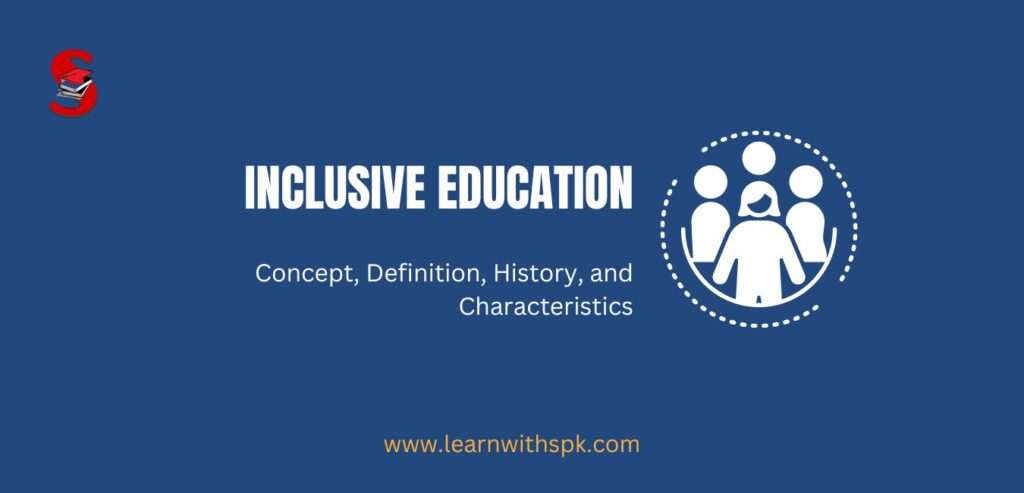What is Inclusive education? What are the important characteristics of inclusion? In this article, we will discuss its concept, its definition, meaning, and history. We will also discuss its concept from the Indian Education Perspective. We will also discuss 11 important characteristics in detail.

Meaning, Concept, Definition, and History of Inclusive Education
Now, we will discuss in detail the concept, meaning, and history of inclusive education. We will also discuss its concept from an Indian Perspective.
Concept of Inclusive Education
Inclusive education is a basic human right and it provides the foundation for a more just society. All learners have the right to education, regardless of their characteristics or difficulties. It is mainly a purposeful effort to provide educational opportunities to all those groups which in the past, have been excluded from having access to education.
To understand this, you have to learn more about the concept of inclusion and its classification.
Inclusive Education in India
In India, it is rather a novel, recent concept that means schools create effective classroom functioning where the educational needs of all children including those with disabilities are addressed.
It means that all students attend and are welcomed by their neighbor schools in age-appropriate, regular classes. They are supported to learn, contribute, and participate in all aspects of the life of the school. It is about how are develop and design our schools, classrooms, programs, and activities so that all students learn and participate together.
History of Inclusive Education
Inclusive education signifies the proclamation, “Children who learn together, learn to live together.” It indicates the education of all children with all others regardless of their strengths and weaknesses.
The major impetus came from the 1994 World Conference on Special Needs in Education in Salamanca. The conference recommended the principle of inclusion in the words, “……Schools should accommodate all children regardless of their physical, intellectual, social, emotional, linguistic, or other conditions”.
This should include disabled and gifted children, street and working children, children from remote or nomadic populations, children from linguistic, ethnic, or cultural minorities, and children from other disadvantaged or marginalized areas or groups.
Definition of Inclusive Education by UNESCO
Very specifically, UNESCO has defined it as, “children with special educational needs have the same right to education as the others and should be able to have access to an ordinary school, which should integrate them in an education system focused around the individual and capable of accommodating his/her needs.”
11 Important Characteristics of Inclusive Education
Following are the 11 important characteristics of Inclusive education.
#1 Recognizing and Accepting Diversity:
Diversity is one important law of nature. Recognition and acceptance of individual differences are its fundamental importance. But these differences are respected and adequate measures for the education of such children are adopted.
#2 Education for all in the schools:
Education for all means that any child regardless of his/her physical state or mental ability may take admission in any of the schools of his or her choice.
#3 Education is a Fundamental Right of all Individuals:
Individuals can have equal, opportunities to get an education. No one can be debarred from enjoying his/her, right to equality to get an education.
#4 Acceptance and Support to Children Having Special Personal and Educational Needs :
This is one of the conspicuous characteristics of inclusive education. Though it is meant for all mainly it concerns looking into the special needs of handicapped, disabled children. Their physical and intellectual conditions are accepted and support the optimum development of their potential.
#5 Teaching Strategies and Curriculums are Flexible:
The curriculum in inclusive education, for primary education is very flexible, especially in meeting the individual and educational needs of disabled children.
Accommodation in teaching strategies and curriculum enhances children’s experience with academic activities and life and helps achieve the desired goals.
#6 Closer Link between General and Special Education:
By the adaptation to an inclusive approach, special education in terms of special classes or special schools has been included and assimilated into the general educational approach in such a way that it is inherently an inseparable part of that. Both have been closely interlinked.
#7 Involvement of Parents and Community:
For an ideal inclusive program, there must be a strong parent-teacher association group and parental involvement in education, especially in the case of handicapped children.
#8 Need-Based Instructional Strategies:
Need-based instructional strategies are one of the most important characteristic features of inclusive education. It means that the school has the flexibility to adopt instructional strategies to the needs of the children.
#9 Planning and Policies are Strong:
The Central and State Govt. both have made very strong plans and policies for the implementation of inclusive education. Because of the legal aspects of inclusive education, a change in the attitudes of people toward disabled and other marginalized groups of children has been seen.
#10 A Child-Centered Approach:
In inclusive education child has a pivotal place in the education system which fulfils the basic theme of education that educational planning and policies, curricula and teaching techniques, curricula and co-curricular activities of school should be central around the needs of the child.
#11 Strengthens General Education System:
The priority of inclusive education is to strengthen the general education system making it more viable for those who have been discriminated against and excluded on one ground or the other. It is to make the general schools an ideal place for making the education of children with disabilities an integral part of it. Now the general education system must assume responsibility to meet the educational needs of all children with disabilities.
Send these Notes to my e mail
Hi good staff